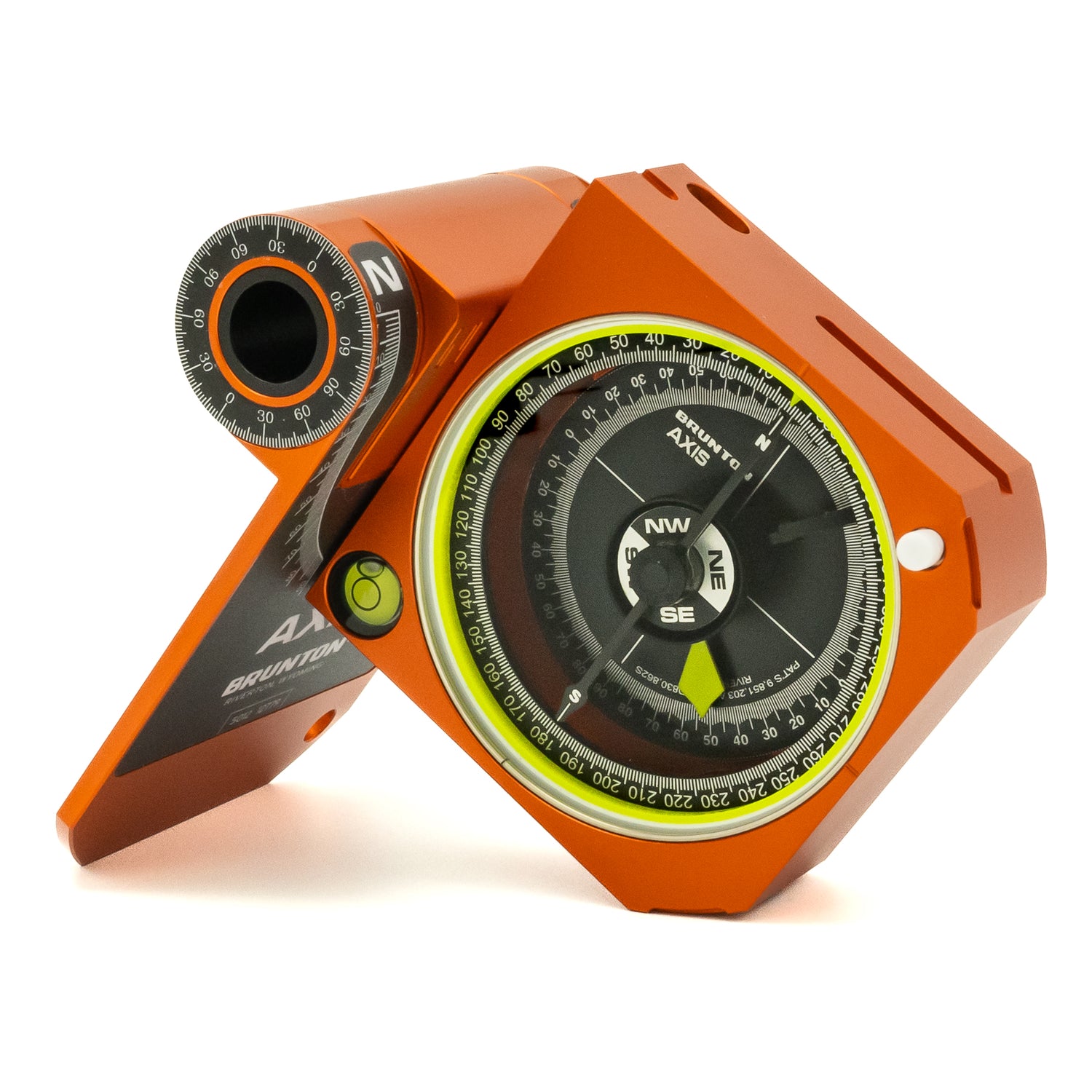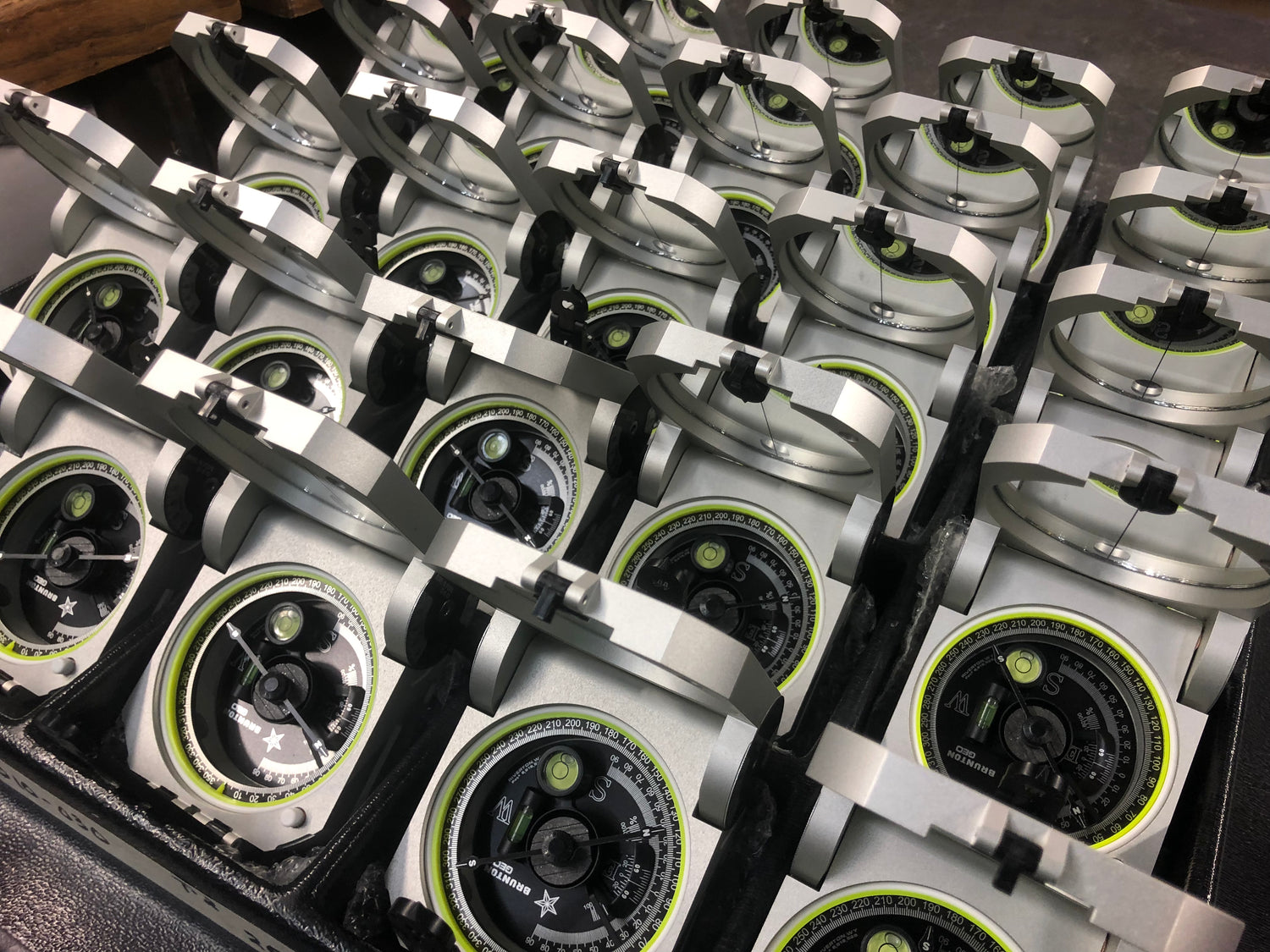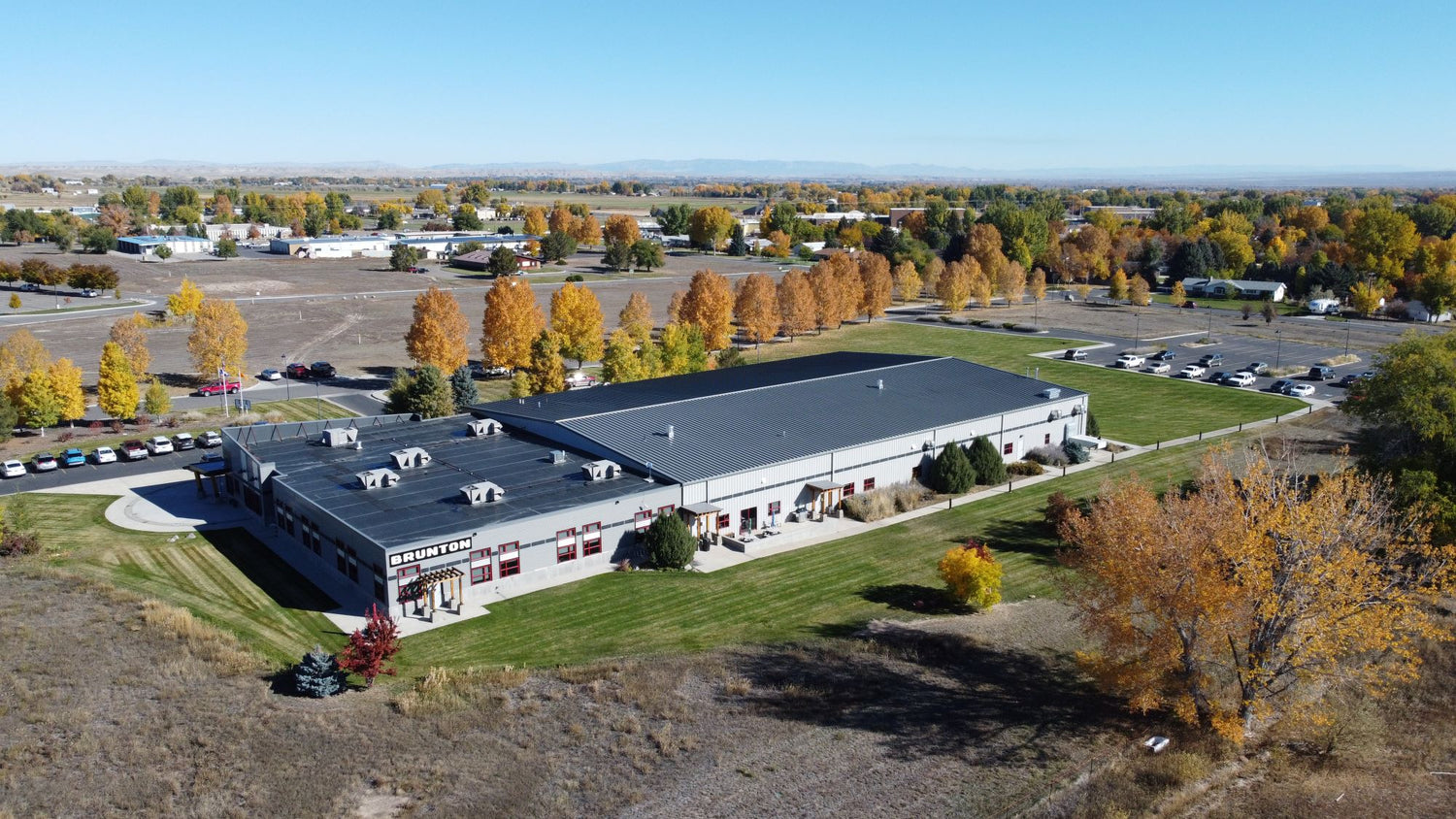GENERAL
What's the difference between a compass and a transit?
- A compass measures directional bearings in the horizontal plane while a transit has a combined clinometer function and can measure both vertical and horizontal angles precisely. At Brunton, we refer to our professional line as "pocket transits" because they are precision surveying tools that fit in one's pocket (or pretty close!). We refer to our recreational line as compasses even though some of them have simple clinometers.
Where are Brunton products made?
- 90% of our current product models are made in our Riverton, Wyoming factory and headquarters. All of our transits and baseplate compasses are made in Riverton, usually from regionally-or domestically-sourced parts. The only items that are not made here in our factory are our monocular line, our current (2022/23) lensatic compass, our Tag-Along Globe, and our monopod/Jacob's Staff. We are committed to increasing the domestic (USA-sourced) percentage of our overall product line and our supply chain over the coming years.
Which "north" do compass point towards?
- Magnetic compass needles align with the combination of magnetic field forces present at your location at the present moment. These forces change in direction and strength over time because Earth's magnetic field is constantly changing. A magnetic compass needle will point towards magnetic north, which is where the three dimensional magnetic field flux lines dive into Earth's interior. Magnetic north is currently somewhere in the Arctic Ocean. Magnetic north is different from geographic or true north, which is where the lines of longitude intersect (and also where Santa Claus lives).
- Read more on our journal post --> Why We Balance our Transits
What is magnetic declination?
- The angle between magnetic and geographic north is called magnetic declination, and it varies based on time and location on the globe. It is important to account for declination either before taking measurements by adjusting your compass or transit, or after your measurement by adding or subtracting the declination angle for your time and place. All Brunton transits and baseplate compasses are adjustable for magnetic declination. See individual product instruction manuals or general instructions below for more details.
Where can I find information about magnetic declination?
- The NOAA Magnetic Declination Calculator is a great place to start: https://www.ngdc.noaa.gov/geomag/calculators/magcalc.shtml.
- NOAA also has a wealth of information about the magnetic field in general and other factors that affect how compass needles behave at various places around the globe.
Are Brunton compass needles global?
- The needles inside Brunton's recreational compass vials are all global.
- Within the GeoLite and OmniSight, the needle magnet is optimized into three zones: Magnetic North, Equator, and South (Omni/GeoLite Magnetic Balance Zone Map(link opens PDF document)).
- Within all of our professional transits, needle magnets are further fine-tuned for a specific zone where they are optimally balanced but will function well for five or more zones north or south (Transit Needle Balance Zones Map(link opens PDF document)).
SUPPORT
Are Brunton products covered by a warranty?
- Yes, our products are covered by a 1-year warranty. Visit our Warranty page for more details.
What products can I send back for repair?
- We only repair transit models that we currently make (Axis, Geo, Standard, ComPro) or have recently phased out (International, Conventional). We will only be able to service phased out models while parts are available.
- Visit our Returns & Repairs page for more details.
Does Brunton still sell binoculars?
- No, but we do have an excellent line of monoculars. We stopped selling and servicing binoculars around 2014.
Do you still service binoculars?
- Unfortunately, Brunton has discontinued our optics in 2014 (binoculars, spotting scopes, and rifle scopes) and we no longer have parts and service for these. These are no longer covered under any warranty since these were part of a previous iteration of the Brunton company.
Does Brunton have parts for discontinued products i.e. camping equipment, portable solar and batteries, headlamps, lighters etc.?
- No, we no longer have inventory or parts for these discontinued lines, and we do not service them.
What can I do if the rubber material on my item is sticky, and why does this happen?
- This can happen to some plastics when they come into contact with certain chemicals such as bug sprays or fabric softeners. Use a window cleaner, soft cloth, and elbow grease to rub this coating off.
What can I try if my ADC has stopped reading correctly?
- Just like a watch, the ADC units do not turn off. The battery will last about a year with normal use. The ADC's take one CR2032 lithium battery. These are very common and can be found at most general stores where batteries are sold.
PROFESSIONAL TRANSITS AND PRODUCTS
Why are East and West swtiched when you look at a transit's base and ring?
- The Brunton Pocket Transit is a direct reading compass. The needle points directly to the bearing on the azimuth ring, which is graduated counter-clockwise. Test out this logic by orienting yourself towards North with the long sight pointing away from you. Then turn 90 degrees to the right. The needle should now be pointing to 90 or E on the azimuth ring.
Why do older transit models have a ring on the bottom?
- This ring was designed to fit into an alidade for plane table surveying/mapping techniques. It also fit into a special protractor for mapping uses. Brunton is phasing this feature out in newer transit models, recessing the area needed for the clinometer arm so the base is flat and does not interfere with low-angle measurements.
How do I open my transit?
- Rotate the pocket transit so the flat cover side faces up, and the small window is positioned away from you. Unlatch the cover from the base of the transit. Sometimes you have to pull pretty hard, so hold on tight to the base with your other hand!
How do I get the needle to spin or lock in my transit?
- The traditional models, ComPro, and Standard transit models have a needle that freely spins unless the rubber needle button is pressed and held down, locking the needle in place for readings. Closing the lid on these models also presses this button, helping lock and protect the needle during transport. The Axis and Geo models have a needle that does the opposite; it is always locked, and pressing the rubber button releases the needle so it can settle to a new reading. Pressing and releasing the needle button slowly three times is enough to help dampen and settle the needle to its new reading. On the Axis and Geo, there is a lever on the compass base that can change the needle function to always freely rotating, but then the rubber button does not do anything.
What can I try if I have a needle that is not spinning smoothly or is sticking?
- Sometimes transport causes a transit needle tostick. Pressing and releasing the needle button can help release it. You can also try releasing the needle and gently tapping on the top and base of the compass to help realign the needle onto its pivot.
How do I adjust my transit for magnetic declination?
- All Brunton transits have a black screw on the front side of the compass base that allows the azimuth ring to rotate in either direction. On some models, there is a small brass screw on the compass base that has to be loosened (but not removed!) before the declination adjustment can take place. To adjust for East declination, rotate the azimuth ring Clockwise so the zero ends up right of the zero pin on the transit. To adjust for West declination, rotate the azimuth ring counter-clockwise so the zero ends up left of the zero pin.
Is my transit "international"?
- Yes, all Brunton transits can be used internationally. The disc magnet within all of the current models allows the needle to function across a wide range of geographic areas. Even if the needle isn't perfectly aligned with the azimuth ring, an accurate reading can be viewed from above. However, due to changes in magnetic inclination (how magnetic needles dip down or up), extreme geographic changes may cause the needle to hit the cover glass or base area and therefore not fully rotate. See the next question...
Why are transit needles balanced for a specific region, and can I use mine in a different region?
- Earth's magnetic field is three-dimensional. Needles don't just point towards magnetic north; they also dip down or up depending on magnetic latitude (inclination). Because Brunton transits are sold around the world, we special balance the needles so they are perfectly balanced in the area of main use. Balancing is done by using Northern or Southern hemisphere disc magnets with different weight distribution, then we bend the N and S ends of the needle to achieve optimal balance. See our Transit Balance Map (link opens PDF document)for more information. A transit can be perfectly accurate and functional until the needle hits the glass or compass base, so it can be used well over five zones north or south of where it is special balanced.
- See Journal entry about Balancing Transit Needles.
Do you repair older models of transits?
- Brunton only services Brunton-made products. Transit models that have been phased out are only serviceable if we have the parts. We currently only can repair transits with 10-digit serial numbers. Start the repair process with our online form.
- Surveys and universities with larger batches of repair requests should contact support@brunton.com directly. We no longer repair batches of Conventional/International transits but have a Transit Exchange Program that can help reduce costs of purchasing new models. If your University/College or Geological Survey are interested in more information about the Transit Exchange Program, please email us at sales@brunton.com
Why hasn't Brunton made a digital transit yet?
- Be patient – we're working on it!
What if my OmniSlope or OmniSight LED stops lighting up?
- We sell a battery repair kit, and the process is pretty easy!
- Find the kit here --> Omni Battery Repair Kit
Do you repair OmniSlopes and OmniSights if the issue is more than just the LED or battery?
- Yes, you can start with the same online form to provide information and receive directions on how to initiate the repair process.
RECREATIONAL PRODUCTS AND COMPASSES
How do I get rid of a bubble in my recreational compass vial?
- A bubble may form in your compass if it has been subjected to cold temperatures and/or low atmospheric pressures (high altitude). Often, all it takes to resolve a bubble issue is returning the compass to warmer temperatures and higher pressures (lower altitude). Placing your compass in the sun is often the best way to warm it up. If a bubble persists or continues to grow larger, then you will need to replace the compass vial (see below).
How do I change out the compass vial?
- Contact support@brunton.com and we can help get you the correct vial and instructions for replacement.
How do I get the needle to spin in my recreational compass?
- Static can build up within a compass vial, despite the liquid. Gently tapping the compass usually helps get the needle spinning again.
Are the recreational compass needles global?
- Yes, all of the needles in our recreational compasses are functional globally with the exception of polar areas where all magnetic compasses experience decreased functionality due to high needle dip angles.
My recreational compass needle has stopped pointing North. What do I do?
- In the rare occasion that a needle is brought close to strong magnets, this can demagnetize the needle and make it nonfunctional. Unfortunately, the only way to fix this is to replace the whole compass vial. Contact support@brunton.com for the correct vial and instructions for replacement.
What are the compass vials filled with and why?
- Our recreational compass vials are filled with a non-toxic organic solvent that can withstand a large temperature range. The purpose of the fluid is to dampen the magnetic needle so it doesn't dither (wobble) and arrives at an accurate reading within a few seconds. The fluid also helps decrease the buildup of static electricity, which can inhibit the needle's rotation.
How do I adjust my baseplate compass for magnetic declination?
- Brunton recreational compasses have tool-less declination adjustments. All you need is to pinch the center of the compass vial between the thumb and forefingers of one hand and rotate the vial relative to the rest of the compass bezel with the help of your other hand. To adjust for East declination, rotate so that zero on the azimuth ring is left of the compass "house". To adjust for West declination, rotate so that azimuth zero is right of the compass "house".
- See our video "Declination Adjustment" for how-to video instructions



